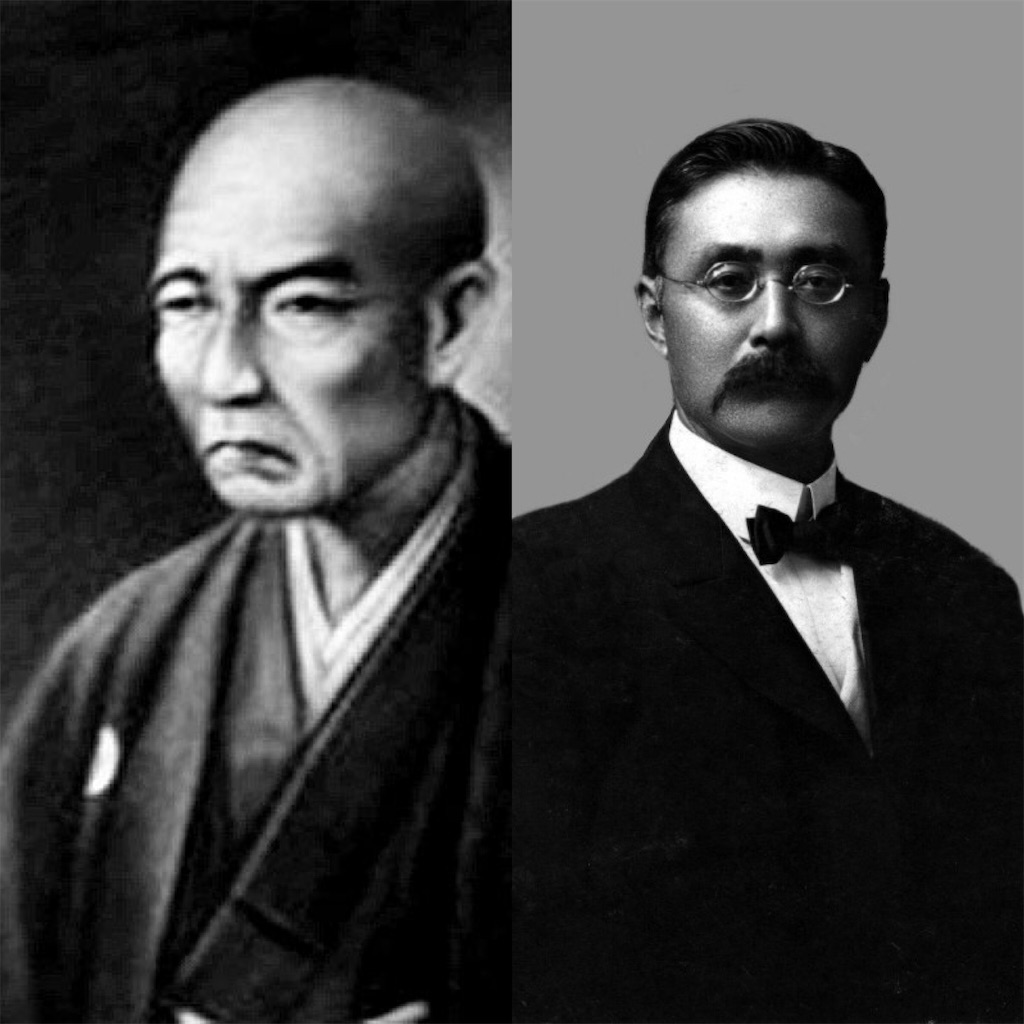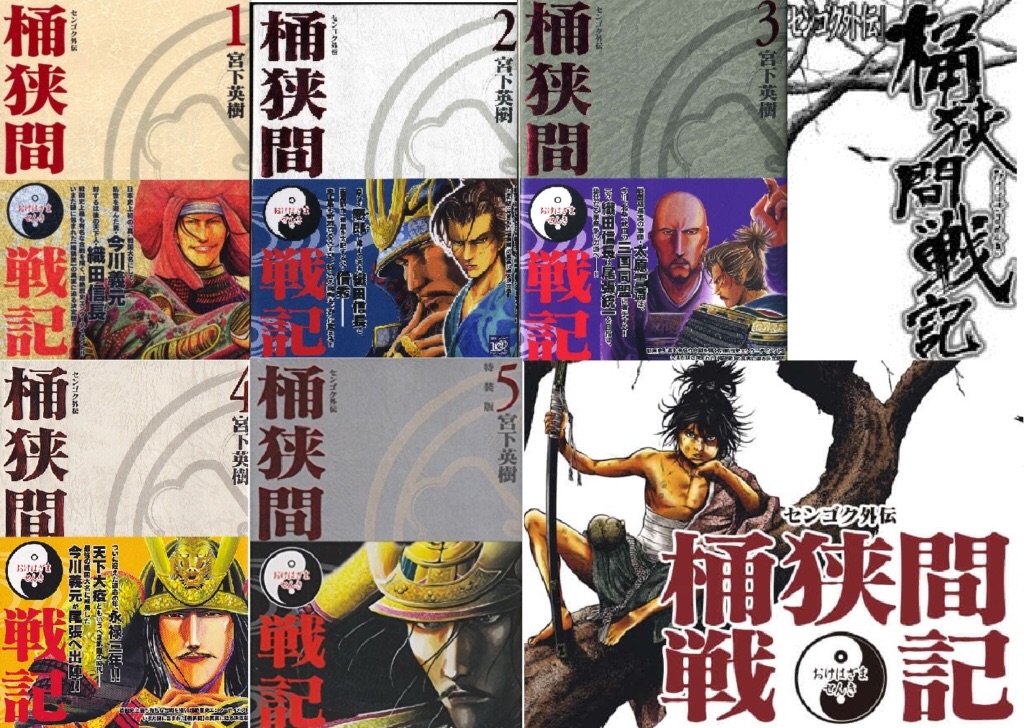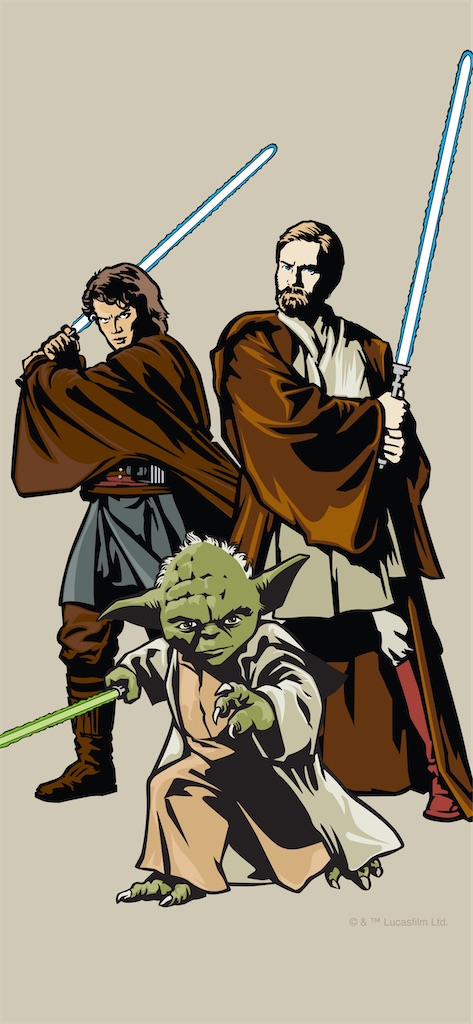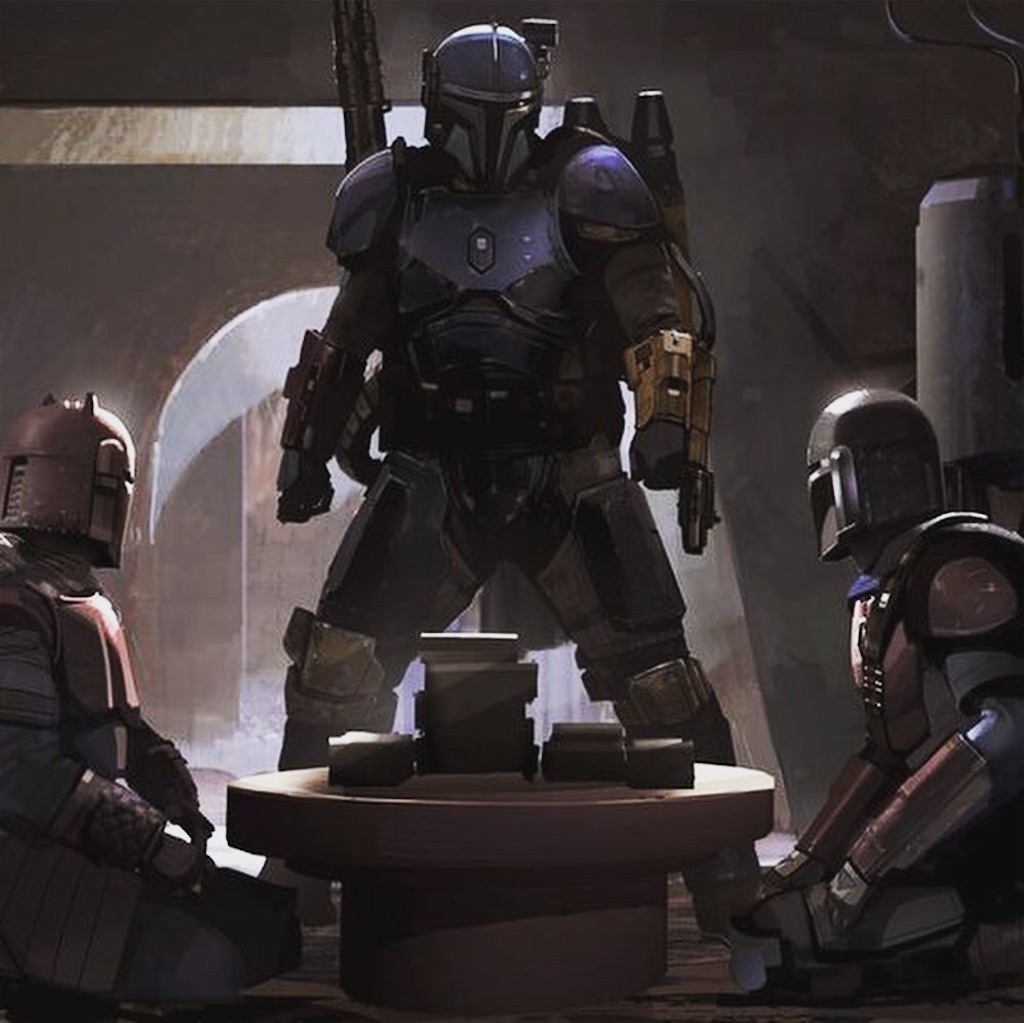''我らの道'': マンダロリアン、ジェダイと武士道 “This is the Way”: Mandalorians, Jedi, and Bushido
初めてのスターウォーズの実写版テレビドラマである「ザ・マンダロリアン」は北米より約一ヶ月半を遅れて2019年末に日本で配信し始め、日本のスターウォーズファンに置いて大好評ともなっている。第一シーズンはいくつのお決まりセリフを生み出して、その中で大変な反響を得たのは「This is the way」である。第三話に出るこのセリフだけど、日本語字幕と吹替ではどのような邦訳になるかとずっと気になっていた。非常に簡単なセリフである一方、その文言(もんごん)に織り込められている意味は深遠である。拙僧の推測では、間違いなく「道」がその訳に入ると想定し、それは見事に的中した:「我らの道」。元の英語の意味合いを訳出しつつ、それと同時により深い意味合いも加えている。その訳を英語に戻すと「This is our way」と成り、「これこそマンダロリアンが歩むすべし道」との意味合いが織り込められているとの解釈にも繋がる。翻訳として傑作に候。
"The Mandalorian" is the first ever live-action Star Wars drama for TV. It began streaming in Japan at the end of 2019, roughly a month and a half after the North American release, and quickly become a big hit among Japanese Star Wars fans. The first season has brought us a number of memorable lines, and many have really taken off. One of these catchphrases is "This is the way", and prior to the Japanese release of the show I had been wondering how it would be translated to Japanese. It's a simple expression, but also one imbued with deep meaning. My hunch was that it would include the Japanese word "michi (道, "way", "path", "road"), and that hunch proved correct: "Warera (我ら) no michi (の道)". This translation captures the original meaning of the English, but also adds another layer of meaning. When this is translated back into English, we get "this is our way”, with the added meaning in the Japanese subtitles/dub implying "this is our way as Mandalorians". It’s a truly sublime translation into the Japanese language.

Source: Disney Japan
「道」という字は数えきれないほど多くの日本語の単語と表現に用いられ、その概念は日本史に置いて奈良時代より遡る。その原点となるのは朝鮮半島を通して日本に伝来した中華思想の一つである「道教(ダオイズム)」と日本文化研究家の松岡正剛氏がいう。「ダオイズムがわからなければ、日本はわからないという面も少なくない。日本には歌道と華道とか、茶道とか、あるいは武士道とか道徳といった言い方がたくさんありますが、そこで使われる “道” という言葉には、どこでダオイズムの “道” が関わっている。すなわち、“究極の方法” が道なのです。英語で言えば “Way” というものだったのです。」
The kanji for the word “michi (道)” is used in countless Japanese words and expressions. The underlying concept for “michi” stretches back to before the Nara Period (eight century A.D.). According to Japanese culture scholar Seigo Matsuoka, the root of this “michi” concept is Taoism, one of the currents of Chinese intellectual thought that made its way to Japan via the Korean peninsula. [The Japanese word for Taoism is 道教 (dokyo), which breaks down to the “way (道) of learning (教)”. “Do (long “o”) '' is how the character is read when paired with other kanji.] Matsuoka writes: “There are many aspects of Japan that only become clear once you understand Taoism. We have a number of different expressions which use the character “道”, such as the two kado (歌道, “way of poetry” and 華道, “way of flower arranging), sado (茶道, “way of tea”), bushido (武士道, “way of the warrior”, and dotoku (道徳, “way of virtue”). The character “道” in each of these expressions connects to the Taoist idea of “the way”, as it is described in English. It refers to a means for pursuing some ultimate form or truth.”
松岡氏が紹介したいくつの「道」の中で特に注目したいのは「武士道」である。海外にもこの単語も知られ、それは日本史の象徴の一つでもある「サムライ(武士)」の掟・生き方であったとの理解がもっとも一般的ではないかと思う。スターウォーズでは代表的な「武士」の集団は二つが存在する:「ジェダイ」と「マンダロイリアン」。そして、この二つの集団がスターウォーズにおいてどのように描写されているかを比較すると、かつて日本で存在した二種類の武士道の対照が窺えて来る。
The one particular “michi” in Matsuoka’s quote that I want to look at here in this post is “bushido (武士道)”, a Japanese word that is fairly well-known in other countries. When people hear the word "bushido", the general concept that comes to mind is the code or way of living of the samurai, the iconic warrior class in the annals of Japanese history. In terms of the Star Wars universe, there are two groups of warriors that stand above the rest: the Jedi and the Mandalorians. A comparison of how these two groups are depicted within the saga brings to light the contrasting nature of the two different modes of "bushido" that existed within Japanese history.
この二つの武士道の中で、一般的に思い浮かばれるのは江戸時代の初期に山本常朝の著作「葉隠」で唱えた武士としての心得である。この「葉隠」は1999年のジム・ジャムシュ監督作品の「ゴスト・ドッグ:ウェイ・オブ・ザ・サムライ」でも取り上げられ、主人公を演じるフォレストウィテカーが映画の中この著作からのいくつの名言を読み上げる。その一つは「武士道とは死ぬことを見つけたり(The Way of the Samurai is found in death)」であった。「葉隠」に次いでもう一つの武士道に関する名著は1899年に英語で書かれて出版された新渡戸稲造の「Bushido: The Soul of Japan」である。当時の日本は凄まじいペースで本格的な近代国家になろうとしていて、そこで日本の伝統的な哲学と思想を海外に向けて分かりやすく解説するため新渡戸氏がこの本を著した。
The variant of bushido that most people think of is the warrior mindset laid out in Jocho Yamamoto's "Hagakure", which was written in the first decades of the Edo Period (1603-1868). "Hagakure" made its way into the 1999 Jim Jarmusch film ”Ghost Dog: Way of the Samurai", with the main character (played by Forrest Whitaker) reading aloud select passages over the course of the movie. One of these was "the way of the samurai is found in death". Another famous book on bushido written and published (in English) by Inazo Nitobe in 1899 was called "Bushido: The Soul of Japan". The nation was working feverishly at that time to transform itself into a full-fledged modern state, and Nitobe took it upon himself to write a work that explained Japan's traditional philosophy and intellectual thought in a straightforward-manner for foreign audiences.

山本常朝 (左) と新渡戸稲造 (右)
Jocho Yamamoto (left) and Inazo Nitobe (right)
約250年で離れて書かれたこの二冊の書にはいくつの共通点がある。まずは二人の著作者の人生を見てみよう。山本が生きた時代は「泰平」の時代とも称される江戸時代であり、本人は戦国時代の終幕であった島原の乱の残酷な鎮圧から22年後の1659年に生まれた。新渡戸氏は江戸幕末の1862年に武士の家で生まれたけど、成人になった頃は江戸幕府、つまり「武士の政権」という時代はもうはや過去のものとなっていた。新渡戸氏が想像した「武士道」はあくまで親と先輩たちから聞いた江戸時代の残影に過ぎなかった。つまり、二人ともは平和の時代しか知らず、戦場の体験は一切なかったとの共通点がある。では、平和の時代においてこの武士道はどのような意義があったのか?日本史上で最も有名な戦である1560年の桶狭間の戦いとその背景を考察する「桶狭間戦記」という漫画の作家宮下秀樹はこう書いた:「それ(武士道)は国内の安定を図るための平和時の道徳規範であり、封建主義の表れの一つであった。」
Some similarities in these treatises on bushido can be drawn, even though they were written about 250 years apart. The first can be found in the lives of the respective authors. Jocho Yamamoto lived in the Edo Period, which is often referred to as "the era of the great peace (泰平 taihei)" in Japanese. He was born in 1659, 22 years after the last vestiges of the Warring States Period (戦国時代 sengoku jidai) were extinguished with the suppression of the Shimabara Rebellion (Tokugawa shogunate's brutal campaign to drive Japanese Christians into the ground). Inazo Nitobe was born into a samurai family in 1862 during a period known as "bakumatsu (幕末)" in Japanese (period when Japan wrestled with whether to remain in quasi-isolation or open up to the West). By the time he was an adult, Japan's age of warrior rule had become a thing of the past. The idea of bushido that he formulated within his mind was based solely on the memories of the Edo period that he heard from his parents and seniors. In short, both of these men only knew eras of peace, and never set foot on the battlefield. The question remains then as to what purpose bushido served in these times of peace. In his historical drama manga "Okehazama Senki (Annals of Okehazama)", which looks at the events leading up to one of the most famous battles in Japanese history, author Hideki Miyashita writes the following: "Bushido represented a set of mores meant to engender domestic stability in times of peace. It was a form of feudalism."

Manga ''Annals of Okehazama'' by Hideki Miyashita
「葉隠」に置いて特にクローズアップされる言葉は先ほど記述した「武士道とは死ぬことを見つけたり」であるけど、そこが大事ではないと松岡氏がいう。松岡氏が注目するのは次の言葉である: 「奉りおきたるこの身」。この言葉が反映するのは江戸時代に定着した朱子学に基づいた思想である。後々の19世紀末に新渡戸が書いた「Bushido」では江戸幕府の国内安定の基盤となったこの朱子学に染めた武士道を引き継がれキリスト教と融合させ、欧米にも通用する「奉りおきたるこの身」という概念を日本の伝統の道徳規範として定義させようとした。
One quote from the "Hagakure" that often gets a lot of attention is the aforementioned "the way of the samurai is found in death" passage. However, the message here is not that important in terms of what this bushido signified, according to Seigo Matsuoka. The quote that really sticks out to him is the following: "pledging oneself to serve (service)". These words are a reflection of the Neo-Confucianism ideals that took root during the Edo period (and were vividly reflected in bushido), providing the base for the domestic stability of the Tokugawa shogunate. Inazo Nitobe later tried to pass these ideals on and fuse them with Christianity in his work "Bushido" to establish a set of "traditional" Japanese mores Western nations could recognize and understand.
スターウォーズに置いて描かれるジェダイオーダー(騎士団)にはこの「奉り」の精神が鮮明に表れている。フォースを、特にライトサイドを信奉するジェダイが、その意志を遵守しながら銀河中の暗黒面を抑制しようとした。平和と正義の守護者として旧銀河共和国に仕えた。ジェダイ・オーダーは厳格な平和維持組織として機能する一方、銀河元老院が銀河を統治し、その1,000年間の平和の時代に法律と秩序を守った。つまり、ジェダイの奉りこそが銀河の平和の礎となっており、旧共和国にとってオーダーは不可欠な存在でもあった。しかし、この奉りはあくまで「平和」に基づいていて、そしてそれはオーダーの破滅を招く原因にも繋がった。分離主義危機により引き起こされたクローン戦争では、旧共和国に対する徹底した奉りを果たすため、ジェダイオーダーは平和の道を降りざるを得なかった。それはやがってオーダーを致命的に弱体させ、戦争の黒幕はフォースの暗黒面を信奉するシスに仕込まれた陰謀であったとやっと気づいたときはもう手遅れだった。
This commitment to service is vividly reflected in the way the Jedi Order is depicted within the Star Wars universe. The Jedi believed in the Force, particularly the Light Side, and strove to follow its will and hold the power of the Dark Side in check throughout the galaxy. They were the guardians of peace and justice of the old Galactic Republic. Their function as a strict peacekeeping organization combined with the auspices of the Galactic Senate’s rule were the formula for the law and order that preserved over a 1,000 years of peace. In short, the Jedi’s dedication to service was the very foundation of the galaxy’s peace, and their existence vital to that of the old Republic. At the same time, this notion of service was rooted in the ideals of peace, and it proved to be a factor that ultimately led to their own downfall. The Clone Wars, which were sparked by the Separatist movement crisis, forced them to venture off the path of pace. This development fatally weakened the Order, and by the time the Jedi realized that the entire conflict was engineered behind the scenes by the Sith, it was already too late.

Source: Disney Japan
さて、もう一つの武士道はどのように生まれたかを検証したいと思う。その武士道は“もう一つ”の武士道というより、「本来」の武士道であったともいえよう。この武士道は日本の戦国時代(1480-1600年ごろ)に生まれた教訓であった。「桶狭間戦記」の漫画で宮下氏が紹介する新歴史学説によるとこの戦国時代は「小氷河期」がもたらした動乱の時代であった。気候学の研究によると1450-1600頃の間は太陽の活動が低下していた。その結果、地球の北半球には長期に渡る寒冷期が訪れ、これが相次いだ大飢饉とも招いた。この飢饉に立ち向かう術(すべ)となったのは「戦争」である。つまり、生き延びるための食料を奪い取るという方法論である。飢饉と上手く対応出来なくなったしまった当時の足利幕府の権力が衰退し、地元の民を救済するために戦国大名という新な勢力が現れた。
Now we’ll take a look at how the other mode of bushido came into being. In fact, it is probably more appropriate to describe it as the “original” form of bushido. This mode of thought manifested itself during Japan’s Warring States period, which lasted from around 1480 to the early 1600s. According to the new historical theory Miyashita outlines in the manga “Annals of Okehazama”, this period in Japanese history was caused by a “little ice age”. Climatology research shows that the sun burned less intensely between 1450 and 1600. This plunged the northern hemisphere into an extended cool period, bringing about an age of successive famines. Against this backdrop, people turned to war as the prescription for avoiding starvation. In short, they elected to fight and take from others the food they needed to survive. The ruling Ashikaga shogunate at that time was unable to mount an adequate response to these famines, which in turn caused its authority to decline. The new forces that stepped into this void to save the people around them were the daimyo, or warlords.

Manga ''Annals of Okehazama'' by Hideki Miyashita
「桶狭間戦記」では宮下氏が戦国時代を生きた二人の武士の残した文言を紹介する:
「七度主君を変えねば武士とは言えぬ」(藤堂高虎家訓)
「犬ともいえ、畜生ともいえ、(武士は)勝つことが本にて候」(朝倉宗滴話第十条)
この二つの文言について、宮下氏はこう書いている:「(この武士の言葉に表れる)それは忠義新や誠心(奉り)などを重んじず、どんな誹謗中傷を受けようとも、生き残るのが真の武士だ…という徹底的な現実主義である。」
In his “Annals of Okehazama”, Miyashita highlights two quotes from samurai that lived during the Warring States period.
“A man who does not change the lord he serves at least seven times cannot be called a bushi (samurai).” (Takatora Todo)
“It does not matter if the means you choose cause people to label you a dog or absolute scum. All that matters (for a samurai) is to win.” (Soteki Asakura).
Miyashita follows up these two quotes with this summary: “These two quotes reveal the hardcore realism ascribed to by samurai in the Warring States period. The ideas of loyalty or sincerity (in otherwords spirit of service) were not their driving motivation. It did not matter to them how much scorn they earned. In their minds, a real samurai was one who survived.”
ここで注目したいのは「生き残る(生き延びる)」との言葉。「マンダロリアン」の第三話「罪」では、主人公が賞金としてもらったベスカー(マンダロリアン族の独特精練の鋼)をアーマーラー(鍛冶屋)の所へ持ってくるシーンで展開する会話にはこの「どの手を尽くしても生き延びる」という精神が良く表れて居る。
The phrase that deserves to be highlighted here is “one who survived”. In episode three “The Sin” of “The Mandalorian”, there is a scene in which the protagonist takes the bounty of Beskar steel (special steel forged by the Mandalorians) he received to a person known as the Armorer. The conversation that transpires here provides a nice window into this “survival by any means” disposition.

Source: Disney Japan
重装兵:「これ(ベスカ―鋼の板)は帝国軍の精錬所で作られたものだ。これは大粛清のときに奪われたんだ。あれ(大粛清)以来、俺達は隠れて住むことになった。
Heavy Infantry: “These (slabs of Beskar) were cast in an Imperial smelter. These are the spoils of the Great Purge. The reason that we live hidden like sand rats.”
アーマーラ―(鍛冶屋):「隠れることは生き延びること。生き延びることは強さよ。
Armorer: “Our secrecy is our survival. Our survival is our strength.”
重装兵:「強さは数だ。今は日陰を忍ぶ身だ。一人ずつしか表に出られん。俺たちの世界は帝国に奪われた。この卑怯者は帝国から仕事をもらっている。」
Heavy Infantry: “Once our strength was in our numbers. Now we live in the shadows and only come above ground one at a time. Our world was shattered by the Empire, with whom this coward shares tables.”
アーマーラ―(鍛冶屋):帝国はもう存在しない。それにベスカが戻ってきた。マンドロアの道を進むことにした者は、ハンターであり獲物でもある。卑怯者はそんな生き方を選ばないはずよ… 我らの道」
Armorer: “The Empire is no longer. And the Beskar has returned. When one chooses to walk the Way of the Mandalore, you are both hunter and prey. How can one be a coward if one chooses this way of life?.. This is the way.”
ハンターは生き延びるために獲物を狩る。そして、獲物は生き延びるためにハンターから逃げ切れる。このシーンを日本語の吹き替えで初めて見たとき、「生き延びることが強さよ」との邦訳が宮下氏の書いた戦国時代の武士道に関する言葉に連想した。ハンターにも獲物にもこの「生き延びる」に徹する性が同じ。つまり、生き延びることが勝利を掴むこと。このセリフが描写する「マンダロアの道」はまさしく戦国時代を生き抜いた武士と同じ理屈に基づいた掟だった。
The hunter hunts their prey in order to survive. The hunted/prey does everything they can to run away from the hunter to survive. The first time I watched this scene in the Japanese dub, the line “ikinobiru koto ga tsuyosa yo (our survival is our strength)” brought to mind what Miyashita wrote about the bushido of the Warring States period. Both the hunter and the hunted possess that same drive to survive. In short, survival is victory. The “Way of the Mandalore” as depicted in this scene signifies a code rooted in the same reasoning espoused by the samurai who lived through the Warring States period.
この「生き延びることが強さよ」というマンダロアの道の神髄が良く表れるもう一つのシーンがある。それは「スター・ウォーズ:クローン・ウォーズ」のシーズン5の第16話の「歪みゆく惑星」というエピソードだ。モールの仕業で内戦に落ちたマンダロア惑星から逃亡するオビ=ワン・ケノビと彼を助け、モールと敵対するマンだロリアン派を率いるボ=カタンが戦中に会話を交わすシーンだ。
There's another scene that I also feel vividly portrays the underlying meaning of the ''our survival is our strength'' pretense. That scene is in episode 16 ''The Lawless'' in season 5 of ''Star Wars: The Clone Wars.'' (Darth) Maul's scheming has plunged Mandalore into civil war. As Obi Wan makes his escape, he is helped by Bo Katan, the leader of the faction standing up to Maul. Here is their conversation as the battle rages around them:
ボ=カタン:「共和国に戻ってここの現状を話して。」
Bo Katan: “Go back to your Republic and tell them what has happened.”
オビ=ワン:「それだと共和国軍がマンダロアに進駐することになる。」
Obi Wan: “But that would likely lead to a Republic invasion of Mandalore.”
ボ=カタン:「ええ、そしてモールが死ぬ。でも、マンダロアが生き残る。これまでもうそうだったようにね。」
Bo Katan: “Yes, but Maul will die, and Mandalore will survive. We always survive.”
その後はボ=カタンが目線を激しい戦場に戻して、両手に持つブラスターを打ち込み続ける。でも、頭の中でオビ=ワンに言った言葉はきっとこう続いたと思う:「我らの道」。だから共和国軍の進駐も覚悟していた。マンダロアが生き残るならどの手を尽くしてもそれを成し遂げるのが「我らの道」だから。
Bo Katan then turns her gaze back to the raging battle, twin blasters firing away into the fray. My head canon believes that in her mind, she finished what she said to Obi Wan with these words: “This is the way.” That is why she was prepared to accept a Republic invasion of her world, because she was willing to do whatever it took to ensure Mandalore’s survival. That is the meaning of “this is the way.”

Source: IGN